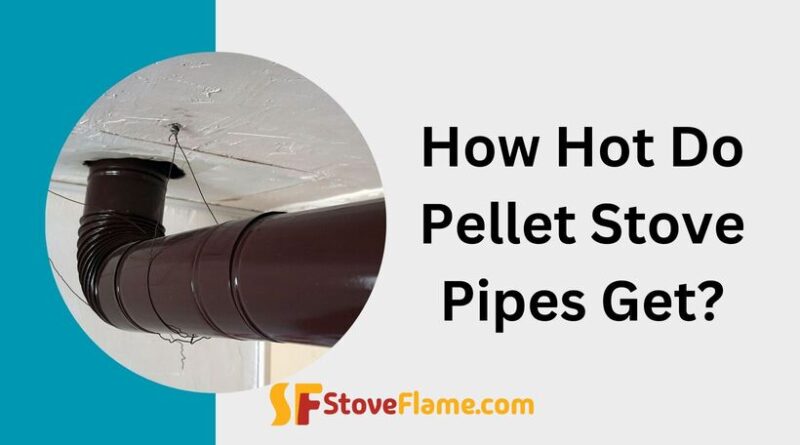How Hot Do Pellet Stove Pipes Get?
Pellet stoves have become increasingly popular in recent years as a cost-effective and environmentally friendly alternative to traditional wood-burning stoves. These stoves use wood pellets as fuel, which are made from compressed sawdust and other organic materials. While the benefits of using pellet stoves are widely known, many homeowners may have questions about the safety and functionality of the appliances.
One common concern is how hot the pellet stove pipes can get during operation. This is an important consideration, as the high temperatures of the pipes can not only affect the performance of the stove, but also pose a potential safety hazard.
This article will discuss pellet stove pipe temperatures, providing a detailed overview of what homeowners should consider. We will cover the various factors that impact pipe temperature and the safety precautions that need to be taken. Whether you already own a pellet stove or are thinking about getting one, it’s important to understand the significance of monitoring pellet stove pipe temperatures.
Understanding Pellet Stove Pipes
When it comes to understanding pellet stove pipes, it’s important to have a clear understanding of their purpose and how they work. Pellet stove pipes serve as the exhaust system for your stove, carrying the byproducts of combustion outside your home. These pipes are specifically designed to handle the high temperatures generated by the stove, ensuring safe and efficient operation. It is crucial to choose the right type and size of pipe to match your pellet stove’s requirements.
Additionally, regular maintenance and inspection of the pipes are essential to ensure they remain in good condition and free from any obstructions. Understanding pellet stove pipes will not only help you operate your stove safely but also maximize its performance and longevity.
Why It Is Important To Know How Hot They Get?
Knowing how hot pellet stove pipes can get is essential for several reasons. Firstly, it ensures the safety of your home and family. Pellet stoves operate at high temperatures, and if the pipes cannot handle these temperatures, it can lead to dangerous situations like overheating, fire hazards, or even carbon monoxide leaks. By understanding the temperature limits of the pipes, you can choose the right materials that can withstand the heat and prevent any potential accidents.
Secondly, knowing how hot the pipes get allows you to properly plan and install your pellet stove system. You can ensure that the pipes are positioned away from flammable materials and properly insulated to prevent heat transfer to surrounding surfaces.
Lastly, understanding the temperature range of pellet stove pipes helps you identify any performance issues or malfunctions. If the pipes are consistently exceeding their temperature limits, it could indicate problems with the stove or the exhaust system that need to be addressed. By being aware of the temperature capabilities of your pellet stove pipes, you can ensure the safe and efficient operation of your heating system.
How Hot Do Pellet Stove Pipes Get?
When it comes to pellet stove pipes, it’s important to be aware of the high temperatures they can reach. This knowledge is crucial for maintaining the safety and efficiency of your pellet stove system. Pellet stove pipes can get extremely hot, often exceeding temperatures of 500 degrees Fahrenheit.
Therefore, it is essential to choose pipes made from materials that can handle these high temperatures without warping or deteriorating.
Additionally, proper installation and insulation are vital to prevent heat transfer to nearby combustible surfaces. Regularly monitoring the temperature of your pellet stove pipes can help you identify any potential issues or malfunctions, ensuring the continued safe and effective operation of your pellet stove system.
Factors That Affect the Temperature of Pellet Stove Pipes
Several factors can influence the temperature of pellet stove pipes in your home. Firstly, the type and quality of pellets used can play a role. Higher-quality pellets tend to burn more efficiently, producing less smoke and therefore generating lower pipe temperatures. On the other hand, lower-quality pellets might produce more smoke, resulting in higher temperatures in the pipes.
Secondly, the rate at which pellets are fed into the stove can impact temperatures. A higher feed rate can lead to a hotter burn and, subsequently, higher pipe temperatures. Conversely, a lower feed rate can result in lower pipe temperatures.
Lastly, the design and length of the pellet stove pipe system can affect temperatures as well. Longer pipe systems or those with multiple bends and elbows may cause more heat loss, resulting in lower pipe temperatures. By considering these factors, you can better understand and manage the temperature of your pellet stove pipes.
Safety Precautions
When it comes to ensuring the safety of your pellet stove and its pipes, there are several precautions you should take. First and foremost, it is crucial to keep the area around the stove clear of any flammable materials such as furniture, curtains, or rugs.
Additionally, make sure to install a proper heat shield or insulating material on the wall behind the stove to protect against excessive heat. Regularly inspect and clean the pellet stove pipes to prevent any buildup of creosote, a highly flammable substance that can lead to chimney fires. It is also essential to have a carbon monoxide detector installed near the stove to alert you of any potential gas leaks.
Lastly, always follow the manufacturer’s guidelines and recommendations for proper installation and usage of your pellet stove to ensure safe and efficient operation. By following these safety precautions, you can enjoy the warmth and comfort of your pellet stove while minimizing any potential risks.
Choosing the Right Type of Pipe
When it comes to choosing the right type of pipe for your pellet stove, there are a few factors to consider. First, you want to ensure that the pipe is made specifically for pellet stoves, as they operate at higher temperatures compared to other types of stoves. Look for pipes that are designated as suitable for pellet stove use, as they are designed to handle the heat and combustion byproducts more effectively.
Additionally, consider the material of the pipe. Stainless steel is a popular choice due to its durability and resistance to corrosion.
Lastly, make sure to choose the appropriate size and configuration of the pipe to fit your specific installation requirements. Consulting with a professional or referring to the manufacturer’s guidelines can help ensure that you select the right type of pipe for your pellet stove, allowing for safe and efficient operation.
Type of Fuel and Stove
Choosing the right type of fuel and stove for your pellet stove is essential for both efficiency and safety. When it comes to fuel, it is crucial to use pellets that are specifically designed for pellet stoves. These pellets are made from compressed sawdust and do not contain any additives that could jeopardize the performance of your stove or create excessive heat.
Using the wrong type of fuel, such as wood logs or other biomass materials, can lead to poor combustion and potentially damage your stove.
Additionally, it is recommended to select a stove that is certified by a reputable organization, such as the Environmental Protection Agency (EPA). These certified stoves are designed to meet strict safety and efficiency standards, ensuring that they operate at optimal levels while minimizing the risk of fire hazards. Taking the time to choose the right type of fuel and stove will not only enhance the performance of your pellet stove, but also provide peace of mind knowing that you are using a safe and reliable heating source.
Potential Risks of Overheating
Overheating is a potential risk that pellet stove owners should be aware of. When a pellet stove is operated at high temperatures for an extended period, it can put excessive stress on the components and increase the risk of malfunctions or even fire hazards.
It is important to monitor the temperature of your pellet stove and ensure that it operates within the recommended range. Regular maintenance, including cleaning the stove and inspecting for any signs of wear or damage, can help mitigate the risks associated with overheating.
Tips for Managing Pellet Stove Pipe Heat
To effectively manage the heat produced by your pellet stove pipe, there are a few helpful tips to keep in mind. Firstly, consider installing a heat shield or insulation around the pipe to maintain a safe distance from combustible materials. This will help prevent any accidental fires or damage.
Additionally, ensure that the pipe is properly sealed and insulated to minimize heat loss and improve the overall efficiency of your stove. Regularly check for any signs of excessive heat buildup, such as discoloration or warping of the pipe, and address any issues promptly.
Lastly, adjusting the air intake and pellet feed settings on your stove can help control the heat output. Experiment with different settings to find the right balance that suits your heating needs while maintaining a safe operating temperature. By implementing these tips, you can effectively manage and control the heat emitted by your pellet stove pipe for a safe and comfortable heating experience.
Final Words
Finally, pellet stoves are a great alternative to traditional wood stoves, offering convenience, efficiency, and ease of use. While the stove pipes do get hot during operation, following safety guidelines and properly maintaining your stove can ensure a safe and enjoyable heating experience.
It’s always a good idea to consult the manufacturer’s instructions and seek professional help if needed. With proper care, you can enjoy the warmth and ambiance of a pellet stove without worrying about excessive heat from the pipes.
I'm Daniel Miller, the proud owner of StoveFlame. With over five years of experience in this dynamic field, I've honed my skills and passion for delivering top-notch quality and accuracy in everything I do.





